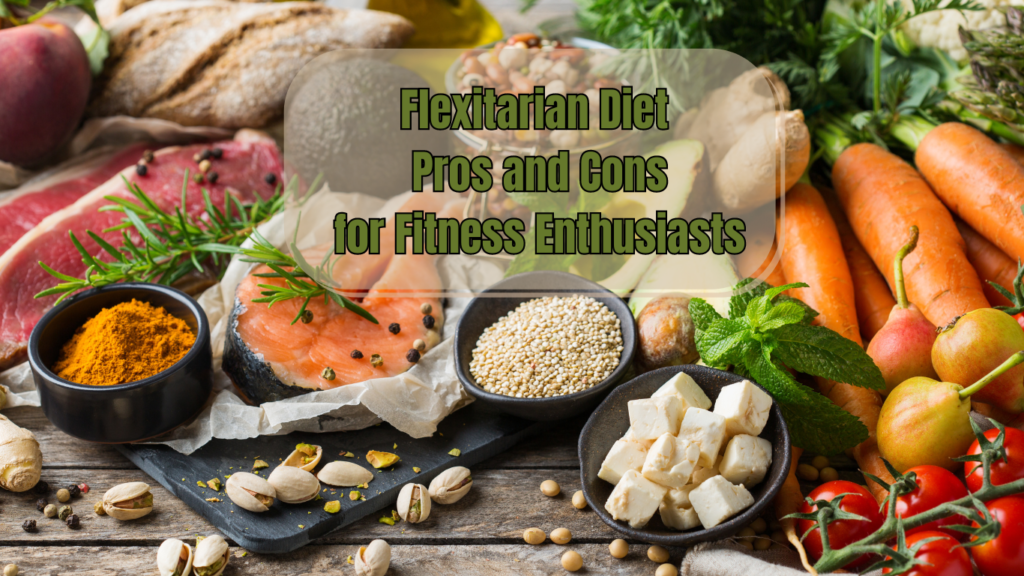Exploring the Flexitarian Diet Pros and Cons: An Introduction
In this article, we’ll explore the Flexitarian Diet pros and cons, helping you understand how this flexible eating plan can fit into your fitness journey.
In the realm of modern fitness trends, the flexitarian diet has emerged as a popular choice for individuals seeking a balanced approach to nutrition. Unlike strict vegetarian or vegan diets, the flexitarian diet offers flexibility by primarily focusing on plant-based foods while occasionally incorporating meat and other animal products. This dietary approach is not just a temporary fad but rather a sustainable lifestyle choice embraced by many fitness enthusiasts and health-conscious individuals alike.
The flexitarian diet revolves around the concept of moderation and mindful eating. By emphasizing plant-based foods such as fruits, vegetables, legumes, and whole grains, it encourages a higher intake of essential nutrients, fiber, and antioxidants. These elements are fundamental in supporting overall health and well-being, which are crucial components of any effective fitness regimen.
One of the key benefits of the flexitarian diet is its adaptability to individual preferences and lifestyles. Unlike more rigid dietary protocols, the flexitarian diet allows individuals to tailor their food choices to meet their specific nutritional needs and goals. This flexibility can make it easier to adhere to over the long term compared to restrictive diets that may feel unsustainable or overly challenging.

Another significant advantage of the flexitarian diet is its potential impact on weight management and body composition. By prioritizing plant-based foods, which tend to be lower in calories and saturated fats, the flexitarian diet can support healthy weight loss or maintenance efforts. This aspect is particularly appealing to those aiming to achieve or sustain a leaner physique without feeling deprived or hungry.
Moreover, the flexitarian diet promotes environmental sustainability by reducing the consumption of animal products, which are typically resource-intensive to produce. This aligns with the growing awareness of the ecological impact of dietary choices and underscores the diet’s broader implications beyond personal health benefits.
However, like any dietary approach, the flexitarian diet has its challenges and considerations. One potential drawback is ensuring an adequate intake of certain nutrients that are more abundant in animal products, such as vitamin B12, iron, and omega-3 fatty acids. While plant-based sources of these nutrients exist, careful planning and supplementation may be necessary for some individuals to prevent deficiencies.
Subscribe And Get Our Free E-Book:Unlocking The Power Of Nutrition-Supplements, Substitutes, and Superfoods!
Additionally, the flexibility inherent in the flexitarian diet may also pose a challenge for those who thrive on structure or specific guidelines. Without clear boundaries, some individuals may find it challenging to maintain balance and may inadvertently overconsume less nutritious foods while focusing on the flexibility aspect of the diet.
Furthermore, the label “flexitarian” itself can be interpreted in various ways, leading to potential confusion or misinterpretation of what constitutes a balanced flexitarian diet. It’s essential for individuals adopting this approach to educate themselves on proper nutrition and make informed choices to reap the full benefits of the diet.
In conclusion, the flexitarian diet presents a compelling option for individuals looking to enhance their fitness journey through balanced nutrition and sustainable eating habits. Its emphasis on plant-based foods while allowing for occasional meat and dairy consumption strikes a practical balance that supports both personal health and environmental stewardship. By understanding the flexitarian diet pros and cons, individuals can make informed decisions that align with their fitness goals and overall well-being.
Health Benefits of the Flexitarian Diet Video
As we delve deeper into this topic, we will explore specific strategies for optimizing a flexitarian diet to maximize fitness outcomes and address common concerns associated with this dietary approach. Stay tuned to uncover how you can integrate the flexitarian diet into your fitness routine effectively and sustainably.
Understanding the Flexitarian Diet
The concept of the flexitarian diet revolves around primarily consuming plant-based foods while occasionally incorporating meat and other animal products. This approach offers a balance between the benefits of a vegetarian diet and the flexibility of including animal proteins. People adopt the flexitarian diet for various reasons, including health benefits, environmental concerns, and personal preference.

One of the core aspects of the flexitarian diet is its flexibility. Individuals can adjust the amount of meat they consume based on their dietary needs and preferences. This flexibility allows for varying degrees of adherence, making it easier for people to maintain this diet over the long term. For some, this might mean eating meat a few times a week, while for others, it might be only on special occasions. The key is to focus on plant-based meals most of the time, which is why understanding the flexitarian diet pros and cons is essential for anyone considering this lifestyle.
The flexitarian diet pros and cons include its potential health benefits and some challenges. On the positive side, this diet can lead to improved overall health due to the increased intake of fruits, vegetables, and whole grains, which are rich in essential nutrients and fiber. Additionally, reducing meat consumption can lower the risk of chronic diseases such as heart disease, diabetes, and certain cancers. However, some individuals may find it challenging to get enough protein and other nutrients typically found in animal products, which is one of the key considerations when evaluating the flexitarian diet pros and cons.
Historical Context and Popularity
The flexitarian diet has its roots in the early 2000s when dietitian Dawn Jackson Blatner popularized the term in her book “The Flexitarian Diet.” Since then, the diet has evolved and gained widespread acceptance. The increasing awareness of the environmental impact of meat production and the health benefits of plant-based diets have contributed to its popularity. Today, many people, including athletes and fitness enthusiasts, are exploring the flexitarian diet pros and cons to see how this approach can fit into their lifestyles.
Athletes and fitness enthusiasts find the flexitarian diet appealing because it allows them to consume high-quality plant-based foods while still incorporating animal products when needed for protein and recovery. This balanced approach helps them meet their nutritional needs without feeling restricted. By understanding the flexitarian diet pros and cons, individuals can make informed decisions about their dietary choices, ensuring they achieve their fitness and health goals effectively.
Comprehensive Overview of Flexitarian Diet: Benefits, Challenges, and Strategies Chart
| Aspect | Benefits/Insights | Challenges/Considerations | Strategies/Recommendations |
|---|---|---|---|
| Nutrient Density | Higher intake of phytonutrients from plant-based foods supports immune function and overall health. | Potential deficiencies in iron, vitamin B12, and omega-3 fatty acids may require supplementation. | Include a variety of nutrient-dense plant foods; consider fortified products and supplements. |
| Sustainability Impact | Reduces greenhouse gas emissions more effectively than strict vegetarian or vegan diets. | Social and practical challenges in maintaining dietary preferences during social gatherings. | Choose restaurants with diverse plant-based options; bring a plant-based dish to share at gatherings. |
| Athletic Performance | Improved recovery times and sustained energy levels during endurance activities. | Difficulty in maintaining macronutrient balance (protein, carbs, fats) for muscle growth. | Incorporate diverse plant-based proteins; consider protein supplements for higher protein needs. |
| Meal Planning Strategies | Ensures balanced amino acid profile for muscle repair and growth with plant-based proteins like quinoa and tofu. | Complex meal planning required to balance plant-based meals with occasional meat consumption. | Batch-cook versatile plant-based dishes; plan meals around protein-rich plant foods and lean meats. |
| Social Adaptability | Ability to prepare versatile plant-based dishes that accommodate diverse dietary preferences. | Potential for inconsistent nutrition due to reliance on processed plant-based foods. | Focus on whole, minimally processed foods; plan ahead for dining out and social events to maintain balance. |
Overall, the flexitarian diet offers a practical and sustainable way to improve one’s diet by focusing on plant-based foods while allowing for occasional meat consumption. As more people become aware of the benefits and challenges associated with this diet, its popularity is likely to continue growing. Whether you are an athlete looking to optimize performance or someone interested in a healthier, more balanced diet, understanding the flexitarian diet pros and cons is crucial in making the best dietary choices for your lifestyle.
Pros of a Flexitarian Diet for Fitness: Health and Performance Benefits
Embracing the flexitarian diet offers numerous health and performance benefits, particularly for those engaged in fitness activities. A plant-rich diet inherently supports overall health, providing a high intake of vitamins, minerals, and antioxidants. These nutrients are crucial for maintaining bodily functions, reducing inflammation, and promoting recovery after intense workouts. Additionally, the high fiber content in plant-based foods aids digestion and helps maintain a healthy weight, which is essential for fitness enthusiasts aiming to optimize their performance.

A major advantage of the flexitarian diet is its impact on endurance, recovery, and sustained energy levels. Plant-based foods are rich in complex carbohydrates, which are essential for fueling prolonged physical activities. These complex carbs are broken down slowly, providing a steady release of energy, thus enhancing endurance during workouts. The flexitarian diet also supports faster recovery times due to its anti-inflammatory properties, mainly derived from fruits, vegetables, nuts, and seeds. This aspect is particularly beneficial for athletes who engage in regular, high-intensity training sessions.
Flexibility in Fitness Goals
One of the standout features of the flexitarian diet pros and cons is its adaptability to various fitness objectives, whether it’s muscle gain, weight loss, or overall fitness maintenance. For those aiming to build muscle, the inclusion of lean animal proteins like chicken, fish, and eggs can provide the necessary amino acids required for muscle repair and growth. Coupled with plant-based proteins from legumes, nuts, and seeds, this diet ensures a balanced intake of protein to support muscle development.
On the other hand, for individuals focused on weight loss, the flexitarian diet offers a lower calorie density while being nutrient-dense. The emphasis on plant-based foods means one can consume larger portions without a significant calorie load, which helps in feeling full and satisfied while maintaining a calorie deficit. Many athletes and fitness enthusiasts have thrived on the flexitarian approach, citing its balance and flexibility as key factors in their success. From marathon runners to bodybuilders, the ability to tailor the diet according to specific needs makes it an attractive option.
Sustainability and Ethical Considerations
The environmental impact of reducing meat consumption is another compelling reason to consider the flexitarian diet pros and cons. The meat industry is a significant contributor to greenhouse gas emissions, deforestation, and water usage. By adopting a diet that focuses more on plant-based foods, individuals can reduce their carbon footprint and contribute to environmental sustainability. This consideration is particularly important to fitness enthusiasts who often value not only their personal health but also the health of the planet.
Ethical considerations also play a crucial role. Many people are drawn to the flexitarian diet because it allows them to reduce their consumption of animal products without fully committing to vegetarianism or veganism. This reduction can align with ethical beliefs about animal welfare and the desire to make more humane choices. For fitness enthusiasts, who often strive for a lifestyle that embodies discipline and conscious choices, these ethical considerations can resonate deeply and provide additional motivation to adhere to the diet.
Psychological Benefits
Beyond the physical and ethical advantages, the flexitarian diet offers psychological benefits that can improve adherence and long-term sustainability. The flexibility inherent in this diet means that individuals do not have to completely eliminate their favorite foods, which can reduce feelings of deprivation and help maintain a positive relationship with food. This balance can lead to a more sustainable eating pattern, as individuals are less likely to feel restricted and more likely to stick with the diet over the long term.
A flexible diet approach can also reduce stress and anxiety associated with strict dieting rules. Knowing that there is room for occasional indulgence can make it easier for people to follow the diet without feeling guilty. This psychological aspect is crucial because it supports a healthier, more holistic approach to eating and fitness, contributing to overall well-being.
In conclusion, the flexitarian diet pros and cons present a well-rounded perspective on how this dietary approach can support fitness goals while offering numerous health, environmental, and psychological benefits. By focusing on plant-based foods and allowing for occasional meat consumption, the flexitarian diet provides a balanced and flexible framework that caters to diverse fitness objectives and personal preferences. This adaptability, combined with the diet’s numerous benefits, makes it an appealing option for those looking to enhance their health and fitness in a sustainable and enjoyable way. Understanding the flexitarian diet pros and cons is essential for making informed dietary choices that align with both personal health goals and broader ethical and environmental considerations.
Cons of a Flexitarian Diet for Fitness: Protein and Nutrient Challenges
While the flexitarian diet offers numerous benefits, it’s essential to consider the potential drawbacks to ensure it supports fitness goals effectively. One significant concern is the potential for nutrient deficiencies, particularly in iron, vitamin B12, and omega-3 fatty acids, which are predominantly found in animal products. Iron is crucial for oxygen transport in the blood, and a deficiency can lead to fatigue and decreased performance, which can be particularly detrimental to athletes and fitness enthusiasts. To mitigate this, it’s important to incorporate plant-based iron sources like lentils, spinach, and fortified cereals, and consider pairing them with vitamin C-rich foods to enhance absorption. Vitamin B12, essential for nerve function and red blood cell production, is another nutrient to watch. As it is primarily found in animal products, flexitarians may need to include fortified foods or supplements to meet their needs.

Protein quality and quantity also pose challenges in the flexitarian diet pros and cons. While plant-based proteins such as beans, lentils, quinoa, and tofu provide valuable nutrients, they often lack one or more essential amino acids necessary for muscle maintenance and growth. To address this, it’s crucial to consume a variety of plant-based proteins throughout the day to ensure a complete amino acid profile. Combining different protein sources, such as beans with rice or hummus with whole-grain pita, can help achieve this balance. For those with higher protein needs, such as bodybuilders or those engaging in intense training, it may be beneficial to include higher-protein animal products like eggs, fish, or lean meats more frequently while still maintaining the overall plant-based focus of the diet.
Social and Practical Challenges
Social and practical challenges are another aspect of the flexitarian diet pros and cons that can affect adherence and overall success. Meal planning can become more complex as individuals strive to balance plant-based meals with occasional meat consumption. This requires careful planning and preparation to ensure that meals are nutritious, varied, and aligned with fitness goals. One strategy is to batch-cook and prepare meals in advance, focusing on versatile plant-based ingredients that can be easily paired with different proteins throughout the week.
Dining out and social gatherings can also present difficulties. Many restaurants may not offer sufficient plant-based options, and social events often feature foods that are not aligned with a flexitarian diet. Navigating these situations requires flexibility and creativity. When dining out, researching menus ahead of time and selecting restaurants with diverse options can help. At social gatherings, bringing a plant-based dish to share or eating a small, balanced meal beforehand can ensure that dietary preferences are met without feeling deprived.
Potential for Inconsistent Nutrition
One of the more nuanced pitfalls of the flexitarian diet pros and cons is the potential for inconsistent nutrition. Because the diet is flexible and less restrictive, there’s a risk of over-relying on processed plant-based foods, which can be high in sodium, unhealthy fats, and added sugars. These foods may not provide the necessary nutrients to support fitness goals and overall health. It’s essential to focus on whole, minimally processed foods to ensure a balanced intake of essential nutrients.
Additionally, maintaining an appropriate macronutrient balance can be challenging. Flexitarians might inadvertently consume too many carbohydrates and fats while falling short on protein. This imbalance can hinder muscle recovery and growth, affecting fitness performance. To prevent this, tracking food intake and ensuring each meal includes a source of protein, healthy fats, and complex carbohydrates can help maintain a balanced diet. Tools like meal-planning apps or consultations with a nutritionist can provide valuable guidance in achieving this balance.
Overall, while the flexitarian diet offers flexibility and health benefits, understanding and addressing its potential challenges is crucial for anyone looking to optimize their fitness and health. By focusing on nutrient-dense, whole foods and planning meals carefully, individuals can mitigate the risks associated with nutrient deficiencies and inconsistent nutrition. Social and practical challenges can be navigated with preparation and flexibility, ensuring that dietary adherence remains strong even in varied settings. Recognizing the flexitarian diet pros and cons helps in making informed choices that align with both personal health goals and broader lifestyle considerations.
While the flexitarian diet is an attractive and adaptable approach to eating, it is not without its challenges. Understanding the flexitarian diet pros and cons allows individuals to make informed decisions about their diet, ensuring they can enjoy the benefits while addressing any potential drawbacks. By staying mindful of nutrient intake, planning meals strategically, and navigating social situations with flexibility, those following a flexitarian diet can successfully support their fitness goals and overall well-being. This balanced approach to eating offers a sustainable way to maintain health and fitness without the rigidity of more restrictive diets, making it a viable option for many.
Practical Tips and Strategies: Meal Planning and Recipes
Embracing the flexitarian diet can be a rewarding and healthful approach to eating, especially when it’s tailored to support fitness goals. Meal planning is crucial for ensuring that the diet remains balanced, nutrient-dense, and aligned with individual fitness objectives. Here are some practical meal planning tips and sample recipes to help you navigate the flexitarian diet pros and cons effectively.
To start, incorporating a variety of nutrient-dense plant-based options is essential. For breakfast, consider a smoothie bowl packed with spinach, kale, frozen berries, and a scoop of plant-based protein powder. Top it with chia seeds, almond butter, and a sprinkle of granola for added texture and nutrients. This combination provides a good mix of vitamins, minerals, and protein to kickstart your day.
For lunch, a quinoa salad with mixed greens, chickpeas, cherry tomatoes, cucumber, avocado, and a lemon-tahini dressing offers a satisfying and balanced meal. Quinoa is a complete protein, meaning it contains all nine essential amino acids, making it an excellent choice for muscle maintenance and growth.
Dinner can include a hearty lentil stew with a side of roasted vegetables. Lentils are rich in protein and fiber, supporting digestion and muscle repair. Pairing them with roasted sweet potatoes, carrots, and Brussels sprouts drizzled with olive oil ensures you’re getting a variety of nutrients.
Snacks are also an important part of the meal plan. Opt for hummus with veggie sticks, a handful of nuts and seeds, or Greek yogurt with a drizzle of honey and fruit. These snacks provide sustained energy and help keep you full between meals.
Supplementation Guidance
Even with careful meal planning, there may be times when supplementation is beneficial to ensure all nutritional needs are met. Understanding the flexitarian diet pros and cons, it’s clear that certain nutrients like vitamin B12 and protein can be challenging to obtain from plant-based sources alone. Vitamin B12 is primarily found in animal products, so flexitarians should consider taking a B12 supplement to maintain healthy nerve function and energy levels.
Protein powders can also be a useful addition, particularly for those engaging in intense fitness routines. Plant-based protein powders made from pea, hemp, or brown rice can be easily added to smoothies, oatmeal, or even baked goods to boost protein intake. This is especially important for muscle recovery and growth, ensuring that the body gets enough protein to repair and build tissues.
Omega-3 fatty acids are another nutrient to consider. While flaxseeds, chia seeds, and walnuts are good plant-based sources, they contain ALA (alpha-linolenic acid), which the body must convert to the more beneficial EPA and DHA forms. A vegan omega-3 supplement derived from algae can help meet these needs more effectively.
Fitness Community Insights
The flexitarian diet is gaining traction within the fitness community, with many professionals and athletes sharing their positive experiences. Understanding the flexitarian diet pros and cons from their perspectives can provide valuable insights and motivation.
Take, for example, a personal trainer who finds the flexitarian diet advantageous for its balance and variety. They may highlight how the diet’s flexibility allows them to tailor their protein intake according to their training schedule, consuming more plant-based meals during recovery phases and incorporating lean animal proteins during periods of intense muscle building.
Similarly, an endurance athlete might share their experience of improved energy levels and faster recovery times thanks to the high antioxidant and anti-inflammatory properties of a plant-based diet. They could describe how incorporating small amounts of fish or chicken a few times a week helps them maintain peak performance without feeling deprived or restricted.
Testimonials from fitness enthusiasts can also emphasize the psychological benefits of the flexitarian diet. Many find that the diet’s flexible nature reduces the stress associated with strict dietary rules, making it easier to stick with in the long term. This sustainability is key to achieving lasting fitness results and overall well-being.
Incorporating these insights into your own approach can help you navigate the flexitarian diet pros and cons more effectively. Whether you’re looking to enhance muscle growth, improve endurance, or simply maintain a balanced diet, understanding and applying these practical tips and strategies can make the flexitarian diet a successful part of your fitness journey.
Flexitarian Diet for Fitness Chart: Workout-Oriented Tips and Meal Ideas
| Fitness Goal | Meal Idea | Flexitarian Approach | Benefits/Strategies |
|---|---|---|---|
| Muscle Gain | Quinoa and Black Bean Bowl | Quinoa, black beans, grilled vegetables, avocado, and a lime-cilantro dressing. | High-protein meal with complete amino acids from quinoa and beans; supports muscle repair and growth. |
| Grilled Chicken with Sweet Potato | Grilled chicken breast served with roasted sweet potato and steamed broccoli. | Lean protein from chicken supports muscle development; complex carbs aid in sustained energy levels. | |
| Endurance | Chickpea and Spinach Curry | Chickpeas cooked in coconut milk with spinach, served with brown rice. | Provides sustained energy from complex carbs and plant-based protein; aids in endurance during workouts. |
| Whole Grain Pasta with Lentil Bolognese | Whole wheat pasta topped with lentil-based tomato sauce, mushrooms, and spinach. | High-fiber, plant-based protein; supports recovery and sustained energy for endurance athletes. | |
| Weight Loss | Spinach and Berry Smoothie | Spinach, mixed berries, almond milk, and a scoop of plant-based protein powder. | Low-calorie, nutrient-dense smoothie; supports weight loss while providing essential nutrients. |
| Tofu and Vegetable Stir-Fry | Tofu stir-fried with mixed vegetables (broccoli, bell peppers, snap peas) in teriyaki sauce. | Low-calorie, high-protein meal; aids in satiety and weight management with minimal fat content. | |
| Recovery | Lentil and Vegetable Soup | Lentils, carrots, celery, and tomatoes simmered with herbs and spices. | High-protein, anti-inflammatory properties aid in muscle recovery and reduce post-workout soreness. |
| Salmon with Quinoa and Asparagus | Grilled salmon fillet served with quinoa and roasted asparagus. | Omega-3 fatty acids from salmon support joint health and reduce inflammation; ideal for recovery meals. |
Fitness Strategies:
- Protein Balance: Incorporate a mix of plant-based proteins (beans, lentils, tofu) and lean animal proteins (chicken, fish) to meet muscle growth and recovery needs.
- Nutrient Timing: Consume meals with complex carbs and protein before and after workouts to fuel performance and aid recovery.
- Hydration: Pair meals with adequate water intake to support digestion, nutrient absorption, and overall workout performance.
- Supplementation: Consider protein supplements for higher protein needs during intense training phases; ensure adequate intake of essential nutrients through varied diet and supplements.
In conclusion, the flexitarian diet offers a versatile and healthful approach to eating that can support a variety of fitness goals. By focusing on nutrient-dense plant-based foods, incorporating strategic supplementation, and learning from the experiences of fitness professionals, you can optimize the benefits of the diet while mitigating its challenges. Recognizing the flexitarian diet pros and cons allows for informed decision-making, ensuring that your dietary choices align with both your health goals and personal preferences. This balanced approach not only supports physical fitness but also promotes a sustainable and enjoyable way of eating that can be maintained for the long term.
Summarizing the Flexitarian Diet Pros and Cons for Fitness
Adopting a flexitarian diet can provide significant benefits for those engaged in fitness activities, but it also comes with its own set of challenges. Understanding the flexitarian diet pros and cons is crucial to making informed dietary choices that align with your fitness goals.
The advantages of the flexitarian diet are numerous. This dietary approach focuses on a plant-rich intake, which inherently supports overall health by providing a high intake of vitamins, minerals, and antioxidants. These nutrients play a vital role in reducing inflammation, promoting recovery, and enhancing performance during physical activities. The diet’s flexibility also allows for tailored nutrition plans that cater to various fitness objectives, from muscle gain to weight loss. This adaptability makes it an appealing option for athletes and fitness enthusiasts who require a balanced and nutrient-dense diet.
However, the challenges cannot be overlooked. Potential nutrient deficiencies, particularly in iron, vitamin B12, and omega-3 fatty acids, can arise due to the reduced consumption of animal products. To address these issues, it’s essential to include a variety of plant-based protein sources and consider supplementation for nutrients that are harder to obtain from plants alone. Social and practical challenges, such as meal planning and dining out, require careful navigation to maintain dietary adherence. Additionally, the risk of inconsistent nutrition due to over-reliance on processed foods or imbalanced macronutrient intake is a potential pitfall that needs attention.
Individual Goals and Preferences Should Guide Dietary Choices
When it comes to diet and fitness, there is no one-size-fits-all solution. The flexitarian diet pros and cons highlight the importance of aligning dietary choices with individual goals and preferences. What works for one person might not work for another, and personalizing your approach is key to achieving sustainable results. Whether your aim is to build muscle, lose weight, or enhance endurance, your diet should support your specific needs and lifestyle.
Myth Busting: Addressing Common Misconceptions
There are several common misconceptions about plant-based diets that need to be addressed. One prevalent myth is that plant-based diets cannot provide enough protein for muscle growth. However, with proper planning, it’s entirely possible to meet protein requirements through plant sources such as beans, lentils, tofu, and quinoa, complemented by occasional animal products in a flexitarian approach.
Another myth is that plant-based diets are inherently deficient in essential nutrients. While it’s true that some nutrients like vitamin B12 and iron are more readily available in animal products, fortified foods and supplements can effectively fill these gaps. The flexitarian diet allows for flexibility, ensuring that nutrient intake remains balanced.
Comparative Analysis: Flexitarian Diet vs. Other Popular Diets
When comparing the flexitarian diet to other popular diets such as vegan and paleo, each has unique impacts on fitness outcomes and sustainability. The vegan diet, which eliminates all animal products, is excellent for reducing environmental impact and promoting ethical eating. However, it requires careful planning to avoid nutrient deficiencies and ensure adequate protein intake. The flexitarian diet offers a more flexible approach, allowing for occasional meat consumption to help meet these nutritional needs without completely eliminating animal products.
The paleo diet, which emphasizes whole foods and excludes grains, legumes, and dairy, can be beneficial for those looking to reduce processed food intake and focus on nutrient-dense foods. However, it can be restrictive and may lead to challenges in maintaining a balanced diet, especially in terms of carbohydrate intake for energy during workouts. The flexitarian diet, by comparison, provides a balanced approach that includes a variety of food groups, making it easier to adhere to in the long term and providing a sustainable way to support fitness goals.
Additional Resources for Flexitarianism and Fitness
For readers interested in learning more about the flexitarian diet and its impact on fitness, there are numerous resources available. Books like “The Flexitarian Diet” by Dawn Jackson Blatner offer comprehensive guides on how to implement this eating plan effectively. Online platforms such as nutrition and fitness blogs, forums, and social media groups provide valuable tips, recipes, and community support. Additionally, consulting with a nutritionist or dietitian can provide personalized advice tailored to individual fitness goals and dietary preferences.
Engage with Our Community
We invite you to engage with our blog’s community for ongoing discussions and support. Share your experiences, ask questions, and connect with others who are exploring the flexitarian diet pros and cons. Your insights and stories can provide inspiration and guidance to fellow fitness enthusiasts on their journey toward healthier, more balanced eating.
In conclusion, understanding the flexitarian diet pros and cons is essential for making informed dietary choices that support fitness goals. By focusing on nutrient-dense, whole foods and incorporating strategic supplementation, individuals can mitigate the risks associated with nutrient deficiencies and inconsistent nutrition. The flexibility and adaptability of the flexitarian diet make it a viable option for many, providing a sustainable and enjoyable way of eating that can be maintained for the long term. Through careful planning, awareness of potential challenges, and engagement with supportive communities, you can successfully navigate the flexitarian diet and achieve your fitness aspirations.


